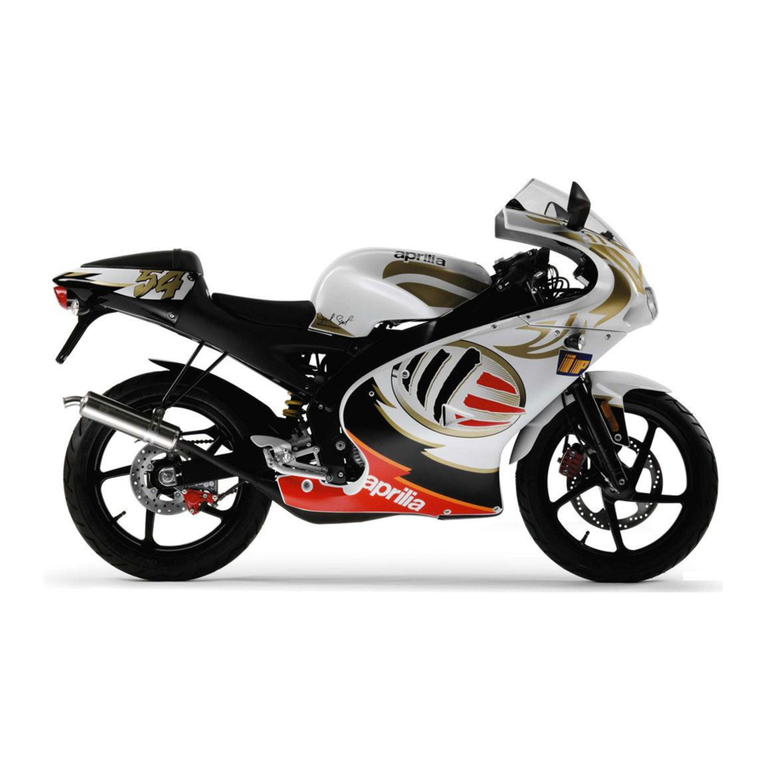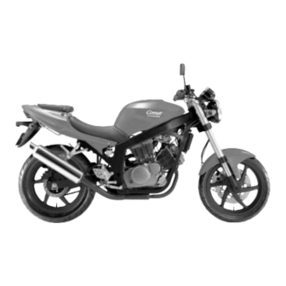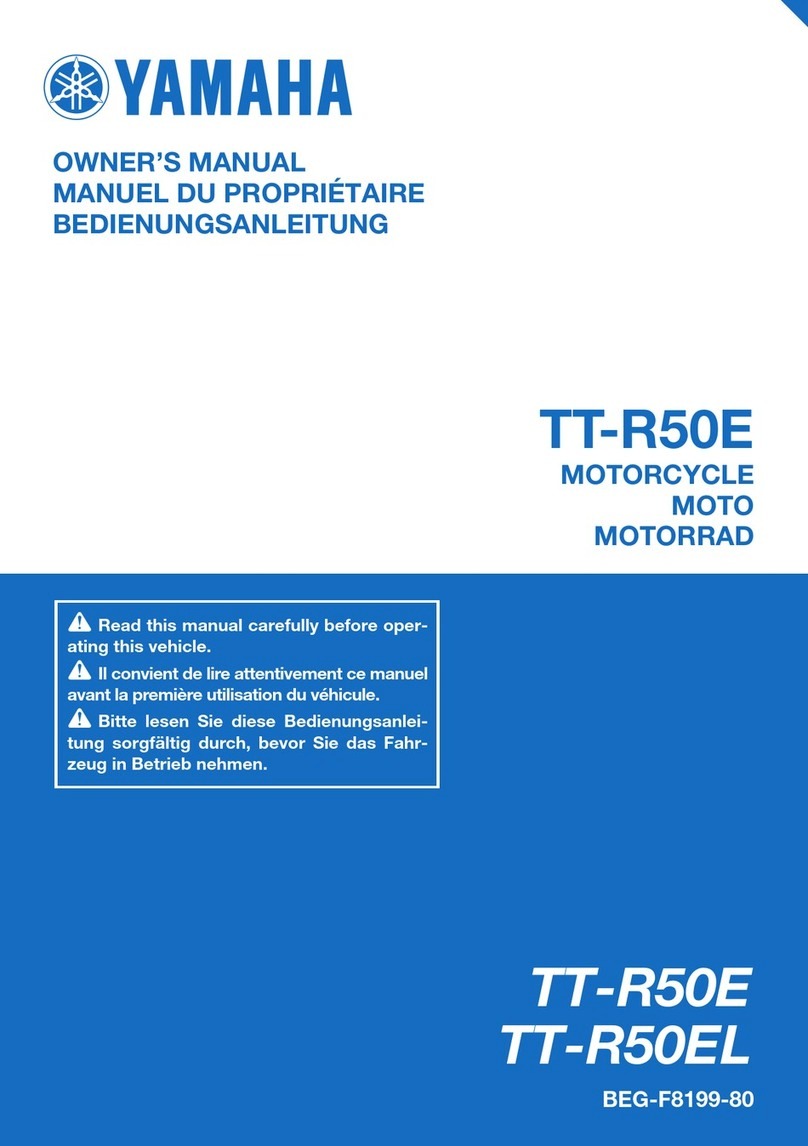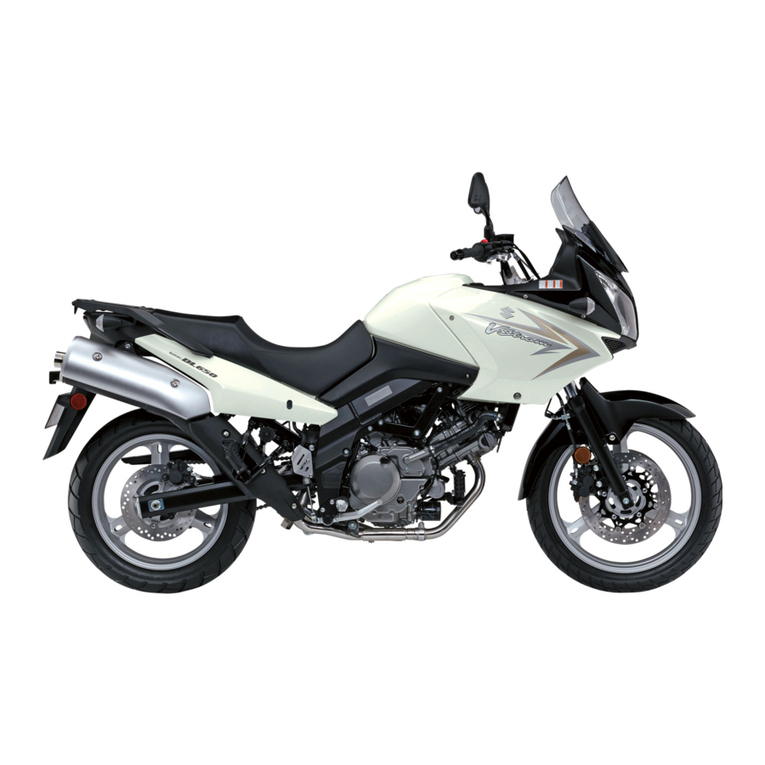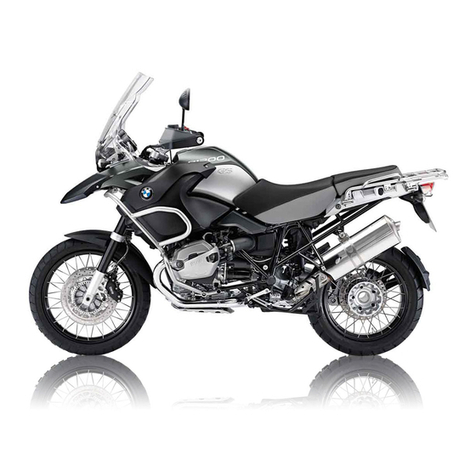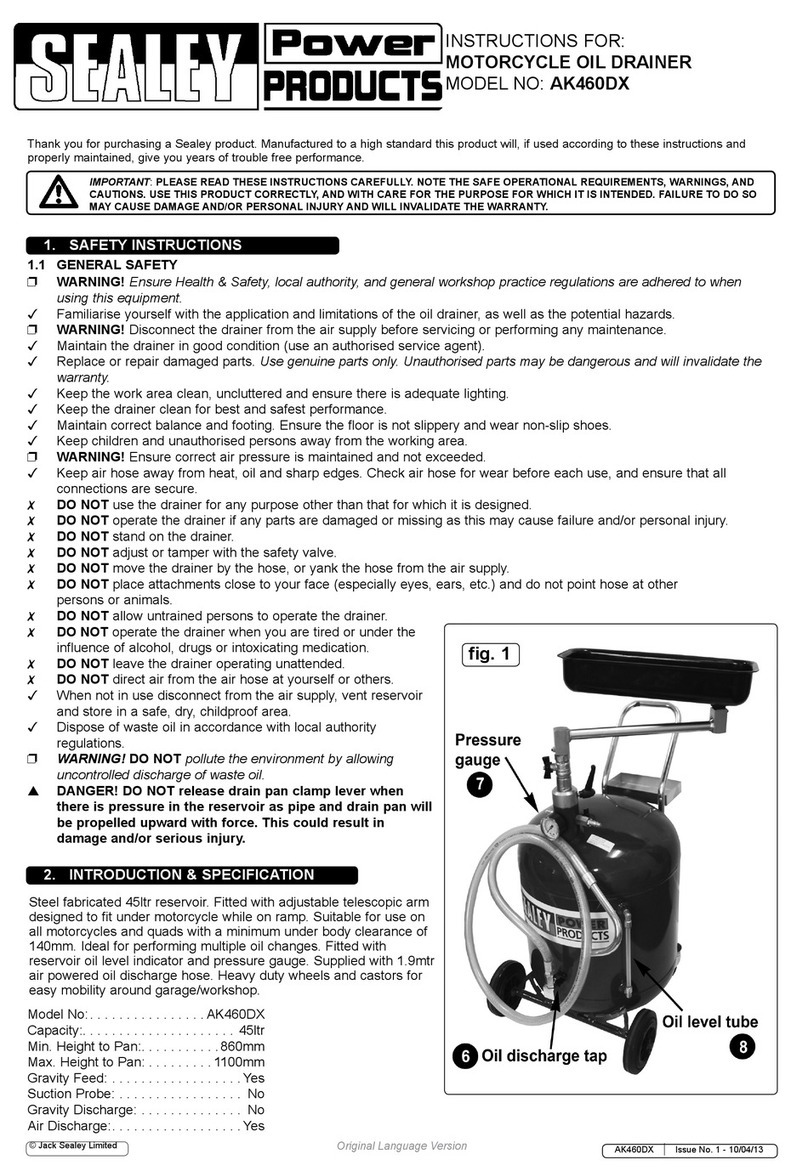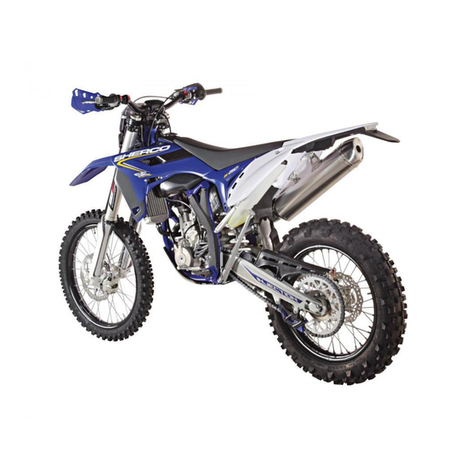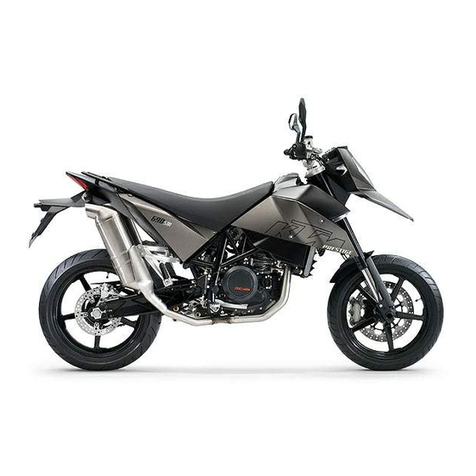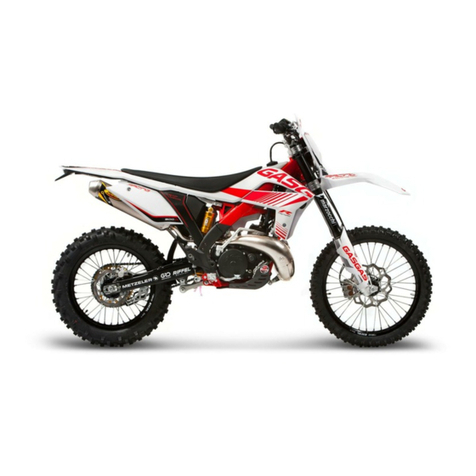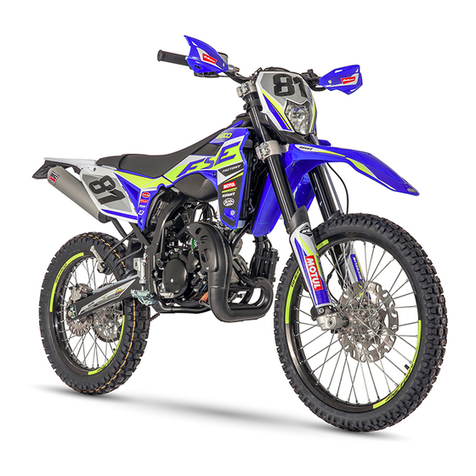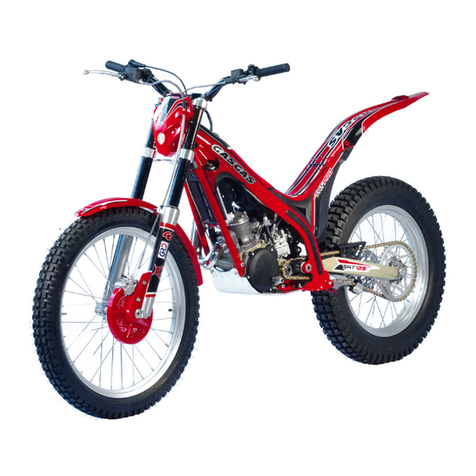Pride Mobility Legend XL User manual

Owner’s Manual
The Ultimate In Style & Performance
®
Exeter, PA
St. Catharines, ON 1-800-800-8586
www.pridemobi ity.com

SAFETY GUIDELINES
Copyright ©2004
Pride Mobility Products Corp.
INFMANU2233/ ev C/December 2004
NOTE: This owners manual is compiled from the latest specifications and product information avail-
able at the time of publication. We reserve the right to make changes as the become necessar . An
changes to our products ma cause slight variations between the illustrations and explanations in this
manual and the product ou have purchased.
The symbols below are used throughout this owner's manual and on the scooter to identify warnings and important
information. It is very important for you to read them and understand them completely.
WARNING! Indicates a potentially hazardous condition/situation that can cause personal
injury, equipment and/or property damage. Black symbol on yellow triangle with black
border).
MANDATORY! These actions should be performed as specified. Failure to perform mandatory
actions can cause injury to personnel and/or damage to equipment white symbol on blue
dot).
PROHIBITED! These actions are prohibited; do not perform at any time or in any situation.
Performing a prohibited action can cause personal injury and/or equipment damage black
symbol with red circle and red slash).
Please fill out the following information for quick reference:
Pride Provider:______________________________ Purchase Date:____________________________
Address:__________________________________________________________________________
Phone Number:_____________________________________________________________________
Serial Number:______________________________________________________________________

3
Legend XL www.pridemobility.com
CONTENTS
I. INTRODUCTION ......................................................................................................................... 4
II. SAFETY ......................................................................................................................................... 5
III. EMI/RFI ........................................................................................................................................ 16
IV. SPECIFICATIONS ................................................................................................................... 18
V. YOUR SCOOTER ...................................................................................................................... 20
VI. BATTERIES AND CHARGING ............................................................................................ 24
VII. OPERATION ............................................................................................................................... 29
VIII. COMFORT ADJUSTMENTS................................................................................................ 31
IX. DISASSEMBLY AND ASSEMBLY ..................................................................................... 34
X. BASIC TROUBLESHOOTING ............................................................................................. 36
XI. CARE AND MAINTENANCE ................................................................................................ 38
XII. WARRANTY ................................................................................................................................40

4www.pridemobility.com Legend XL
I. INTRODUCTION
SAFETY
WELCOME to Pride Mobility Products Corporation (Pride). The product you have purchased combines state of
the art components with safety, comfort and styling in mind. We are confident the design features will provide you
with the conveniences you expect during your daily activities. Understanding how to safely operate and care for
this product should bring you years of trouble free operations and service.
Read and follow all instructions, warnings, and notes in this manual and all other accompanying literature before
attempting to operate this product for the first time. In addition, your safety depends upon you, as well as your
provider, caretaker, or healthcare professional in using good judgement.
If there is any information in this manual which you do not understand, or if you require additional assistance for
setup or operation, please contact your authorized Pride Provider. Failure to follow the instructions, warnings,
and notes in this manual and those located on your Pride product can result in personal injury or product
damage and will void Prides product warranty.
PURCHASER’S AGREEMENT
By accepting delivery of this product, you promise that you will not change, alter or modify this product or remove
or render inoperable or unsafe any guards, shields, or other safety features of this product; fail, refuse or neglect to
install any retrofit kits from time to time provided by Pride to enhance or preserve the safe use of this product.
INFORMATION EXCHANGE
We want to hear your questions, comments, and suggestions about this manual. We would also like to hear about
the safety and reliability of your new scooter, and about the service you received from your authorized Pride
Provider. Please notify us of any change of address, so we can keep you apprised of important information about
safety, new products, and new options that can increase your ability to use and enjoy your scooter. Please feel free
to contact us at the address below:
Pride Mobility Products Corporation
Attn: Customer Care Department
182 Susquehanna Ave.
Exeter, PA 18643-2694
NOTE: If ou ever lose or misplace our product registration card or our cop of this manual, contact
us and we will be glad to send ou a new one immediatel .
PRIDE OWNERS CLUB
As an owner of a Pride product, you are encouraged to enroll in the Pride Owners Club. Complete and return your
enclosed product registration card or visit Pride's web site at www.pridemobility.com.
From our home page, select Owners Club to enter a page dedicated to current and potential Pride product
owners. You will gain access to interviews, stories, recreation ideas, daily living tips, product and funding informa-
tion, and interactive message boards. These message boards invite you to communicate with other Pride custom-
ers as well as Pride representatives who are available to assist you with any questions or concerns.

5
Legend XL www.pridemobility.com
II. SAFETY
PRODUCT SAFETY SYMBOLS
The symbols below are used on the scooter to identify warnings, mandatory actions, and prohibited actions. It is
very important for you to read and understand them completely.
Pinch/Crush points created during assembly.
Corrosive chemicals contained in battery. Use only AGM or Gel-Cell
batteries to reduce the risk of leakage or explosive conditions.
Read and follow the information in the owners manual.
Maximum seating weight.
Place unit on level ground and stand to one side when changing from
drive mode to freewheel mode or freewheel mode to drive mode.
Locked and in drive mode.
Unlocked and in freewheel mode.
Use only AGM or Gel-Cell batteries.

6www.pridemobility.com Legend XL
Front-to-rear plug orientation.
Do not raise or lower the power seat while the scooter is in motion.
Do not remove anti-tip wheels.
Do not use a cell phone, walkie/talkie, laptop, or other radio transmitter while
operating.
Avoid exposure to rain, snow, ice, salt, or standing water whenever possible.
Maintain and store in a clean and dry condition.
Removal of grounding prong can create electrical hazard. If necessary, properly
install an approved 3-pronged adapter to an electrical outlet having 2-pronged plug
access. Failure to heed could result in personal injury and/or property damage.
Prevent personal injury and equipment damage. Do not connect an extension cord
to the AC/DC converter or the battery charger.
II. SAFETY
Contact with tools can cause electrical shock.

7
Legend XL www.pridemobility.com
II. SAFETY
GENERAL
Your scooter is a state-of-the-art life-enhancement device designed to increase mobility. Pride provides an exten-
sive variety of products to best fit the individual needs of the scooter user. Please be aware that the final selection
and purchasing decision regarding the type of scooter to be used is the responsibility of the scooter user who is
capable of making such a decision and his/her healthcare professional (i.e., medical doctor, physical therapist, etc.).
There are certain situations, including some medical conditions, where the scooter user will need to practice
operating the scooter in the presence of a trained attendant. A trained attendant can be defined as a family member
or care professional specially trained in assisting a scooter user in various daily living activities.
As you begin using your scooter during daily activities, you will probably encounter situations in which you will
need some practice. Simply take your time and you will soon be in full and confident control as you maneuver
through doorways, on and off of elevators, up and down ramps, and over moderate terrain.
Below are some precautions, tips, and other safety considerations that will help the user become accustomed to
operating the scooter safely.
MODIFICATIONS
Pride has designed and engineered your scooter to provide maximum mobility and utility. However, under no
circumstances should you modify, add, remove, or disable any feature, part, or function of your scooter.
WARNING! Do not modify your scooter in any way not authorized by Pride. Unauthorized
modifications may result in personal injury and/or damage to your scooter.
REMOVABLE PARTS
WARNING! Do not attempt to lift or move your scooter by any of its removable parts.
Personal injury and damage to the scooter may result.
MANDATORY! Do not operate your new scooter for the first time without completely reading
and understanding this owners manual.

8www.pridemobility.com Legend XL
II. SAFETY
PRE-RIDE SAFETY CHECK
Get to know the feel of your scooter and its capabilities. Pride recommends that you perform a safety check before
each use to make sure your scooter operates smoothly and safely. For details on how to perform these necessary
inspections, see XI. Care and Maintenance.
Perform the following inspections prior to using your scooter:
nCheck for proper tire inflation (if equipped with pneumatic tires).
nCheck all electrical connections. Make sure they are tight and not corroded.
nCheck all harness connections. Make sure they are secured properly.
nCheck the brakes.
nCheck battery charge.
If you discover a problem, contact your authorized Pride Provider for assistance.
TIRE INFLATION
If your scooter is equipped with pneumatic tires, you should check or have the air pressure checked at least once
a week. Proper inflation pressures will prolong the life of your tires and help ensure the smooth operation of your
scooter.
WARNING! It is critically important that 30-35 psi tire pressure be maintained in pneumatic
tires at all times. Do not underinflate or overinflate your tires. Low pressure may result in
loss of control, and overinflated tires may burst. Failure to maintain 30-35 psi tire pressure
in pneumatic tires at all times may result in tire and/or wheel failure, causing serious
personal injury and/or damage to your scooter.
WARNING! Inflate your scooter tires from a regulated air source with an available pressure
gauge. Inflating your tires from an unregulated air source could overinflate them, resulting
in a burst tire and/or personal injury.
WEIGHT LIMITATIONS
Your scooter is rated for a maximum weight capacity. efer to the specifications table for information.
WARNING! Exceeding the weight capacity voids your warranty and may result in personal
injury and damage to your scooter. Pride will not be held responsible for injuries and/or
property damage resulting from failure to observe weight limitations.
WARNING! Do not carry passengers on your scooter. Carrying passengers may result in
personal injury and/or property damage.
INCLINE INFORMATION
More and more buildings have ramps with specified degrees of inclination, designed for easy and safe access. Some
ramps may have turning switchbacks (180-degree turns) that require you to have good cornering skills on your scooter.
nProceed with extreme caution as you approach the downgrade of a ramp or other incline.
nTake wide swings with your scooter around any tight corners. If you do that, the scooters rear wheels will
follow a wide arc, not cut the corner short, and not bump into or get hung up on any railing corners.
nWhen driving down a ramp, keep the scooters speed adjustment set to the slowest speed setting to ensure a
safely controlled descent.
nAvoid sudden stops and starts.

9
Legend XL www.pridemobility.com
II. SAFETY
When climbing an incline, try to keep your scooter moving. If you must stop, start up again slowly, and then
accelerate cautiously. When driving down an incline, do so by setting the speed adjustment dial to the slowest
setting and driving in the forward direction only. If your scooter starts to move down the incline faster than you
anticipated or desired, allow it to come to a complete stop by releasing the throttle control lever. Then push the
throttle control lever forward slightly to ensure a safely controlled descent.
WARNING! When climbing an incline, do not zigzag or drive at an angle up the face of the
incline. Drive your scooter straight up the incline. This greatly reduces the possibility of a
tip or a fall. Always exercise extreme caution when negotiating an incline.
WARNING! Do not drive your scooter across the side of an incline or diagonally up or down
an incline; do not stop, if possible, while driving up or down an incline.
WARNING! You should not travel up or down a potentially hazardous incline i.e., areas
covered with snow, ice, cut grass, or wet leaves).
WARNING! When on any sort of an incline or decline, never place the scooter in freewheel
mode while seated on it or standing next to it.
WARNING! Even though your scooter is capable of climbing slopes greater than those
illustrated in figure 1, do not, under any circumstances, exceed the incline guidelines or
any other specifications presented in this manual. Doing so could cause instability in your
scooter, resulting in personal injury and/or damage to your scooter.
Figure 1. Maximum Recommended Incline Angles
WARNING! Any attempt to climb or descend a slope steeper than what is shown in figure
1 may put your scooter in an unstable position and cause it to tip, resulting in personal
injury.
WARNING! Never carry an oxygen tank weighing more than 15 lbs. Never fill the rear
basket with contents exceeding 15 lbs.
5˚/8.7%
6˚/10.5%
7˚/12.3%
250 lbs. 300-400 lbs.
200 lbs.
8˚/14.1%
150 lbs.
Handicap public access ramps are not subject to government regulation in all countries, and therefore do not
necessarily share the same standard degree of slope. Other inclines may be natural or, if man-made, not designed
specifically for scooters. Figure 1 illustrates your scooters stability and its ability to climb grades under various
weight loads and under controlled testing conditions.
These tests were conducted with the scooters seat in the highest position and adjusted rearward on the seat base
to its farthest rearward position. Use this information as a guideline. Your scooters ability to travel up inclines is
affected by your weight, your scooters speed, your angle of approach to the incline, and your scooter setup.

10 www.pridemobility.com Legend XL
CORNERING INFORMATION
Excessively high cornering speeds can create the possibility of tipping. Factors which affect the possibility of
tipping include, but are not limited to, cornering speed, steering angle (how sharply you are turning), uneven road
surfaces, inclined road surfaces, riding from an area of low traction to an area of high traction (such as passing from
a grassy area to a paved area especially at high speed while turning), and abrupt directional changes. High
cornering speeds are not recommended. If you feel that you may tip over in a corner, reduce your speed and
steering angle (i.e., lessen the sharpness of the turn) to prevent your scooter from tipping.
WARNING! When cornering sharply, reduce your speed. When using your scooter at higher
speeds, do not corner sharply. This greatly reduces the possibility of a tip or fall. To avoid
personal injury or property damage, always exercise common sense when cornering.
II. SAFETY
Figure 2A. Increased Stability Driving Position
Figure 2. Normal Driving Position
BRAKING INFORMATION
Your scooter is equipped with these powerful brake systems:
negenerative: Uses electricity to rapidly slow the vehicle when the throttle control lever returns to the center/
stop position.
nDisc Park Brake: Activates mechanically after regenerative braking slows the vehicle to near stop, or when
power is removed from the system for any reason.
n(Optional) Handbrake: Gives you additional stopping power when squeezed.
When you approach an incline, it is best to lean forward. See figures 2 and 2A. This shifts the center of gravity of
you and your scooter toward the front of the scooter for improved stability.
NOTE: When negotiating ramps, if the throttle control lever is released while moving forward, the
powered scooter ma "rollback" approximatel 1 foot before the brake engages. If the throttle control
lever is released while moving in reverse, the powered scooter ma "rollback" approximatel 3 feet
before the brake engages.

11
Legend XL www.pridemobility.com
II. SAFETY
OUTDOOR DRIVING SURFACES
Your scooter is designed to provide optimum stability under normal driving conditionsdry, level surfaces com-
posed of concrete, blacktop, or asphalt. However, Pride recognises that there will be times when you will encoun-
ter other surface types. For this reason, your scooter is designed to perform admirably on packed soil, grass, and
gravel. Feel free to use your scooter safely on lawns and in park areas.
neduce your scooters speed when driving on uneven terrain and/or soft surfaces.
nAvoid tall grass that can become tangled in the running gear.
nAvoid loosely packed gravel and sand.
nIf you feel unsure about a driving surface, avoid that surface.
STREETS AND ROADWAYS
WARNING! Use extreme caution when operating your scooter on public streets and roadways.
Be aware that it may be difficult for traffic to see you when you are seated on your scooter.
Obey all local pedestrian traffic rules. Wait until your path is clear of traffic, and then
proceed with extreme caution.
STATIONARY OBSTACLES (STEPS, CURBS, ETC.)
WARNING! Do not drive near raised surfaces, unprotected ledges, and/or drop-offs curbs,
porches, stairs, etc.).
WARNING! Do not attempt to have your scooter climb or descend an obstacle that is
inordinately high. Serious personal injury and/or damage may result.
WARNING! Do not attempt to have your scooter proceed rearward down any step, curb, or
other obstacle. This may cause the scooter to tip and cause personal injury.
WARNING! Be sure your scooter is traveling perpendicular to any curb you may be required
to ascend or descend. See figures 3 and 3A.
WARNING! Do not attempt to negotiate a curb that has a height greater than 2 in.
Figure 3. Correct Curb Approach Figure 3A. Incorrect Curb Approach

12 www.pridemobility.com Legend XL
INCLEMENT WEATHER PRECAUTIONS
Exposure of your scooter to inclement weather conditions should be avoided whenever possible. If suddenly
caught up in rain, snow, severe cold or heat while operating your scooter proceed to shelter at the earliest oppurtunity.
Thoroughly dry your scooter before storing, charging, or operating your scooter.
WARNING! Operating in rain, snow, salt, mist/spray conditions, and on icy/slippery surfaces
can cause personal injury and/or damage to the scooter and electrical system. Maintain
and store your scooter in a dry and clean condition.
FREEWHEEL MODE
Your scooter is equipped with a manual freewheel lever that, when pushed forward, allows the scooter to be
pushed. For more information about how to place your scooter into and out of freewheel mode, see V. Your
Scooter.
WARNING! When your scooter is in freewheel mode, the braking system is disengaged.
n Disengage the drive motors only on a level surface.
n Ensure the key is removed from the key switch.
n Stand behind the scooter to engage or disengage freewheel mode. Never sit on a
scooter to do this.
n After you have finished pushing your scooter, always return it to the drive mode to lock
the brakes.
Failure to heed the above could result in personal injury and/or damage to your scooter.
An added feature built into the Legend XL is push-too-fast protection which safeguards the scooter against
gaining excessive speed while in freewheel mode.
Push-too-fast operates differently depending on which of two conditions exists:
nIf the key is switched off while in freewheel mode, the scooters controller activates regenerative braking
when the scooter is pushed faster than a maximum threshold which has been preprogrammed. In this case, the
controller is acting as a speed governor.
nIf the key is switched on while in freewheel mode, you will encounter considerable resistance at any speed.
This prevents the scooter from gaining unwanted momentum should the manual freewheel lever inadvertently
be released while driving the scooter.
STAIRS AND ESCALATORS
Scooters are not designed to travel up or down stairs or escalators. Always use an elevator.
WARNING! Do not use your scooter to negotiate steps or escalators. You may cause injury
to yourself and to others and/or damage your scooter.
II. SAFETY

13
Legend XL www.pridemobility.com
DOORS
nDetermine if the door opens toward or away from you.
nUse your hand to turn the knob or push the handle or push-bar.
nDrive your scooter gently and slowly forward to push the door open. Or drive your scooter gently and slowly
rearwards to pull the door open.
ELEVATORS
Modern elevators have a door edge safety mechanism that, when pushed, reopens the door(s).
nIf you are in the doorway of a elevator when the door(s) begin to close, push on the rubber door edge or allow
the rubber door edge to contact the scooter and the door will reopen.
nUse care that pocketbooks, packages, or scooter accessories do not become caught in elevator doors.
NOTE: If our scooters turning radius is greater than 60 in. it ma be difficult to maneuver in eleva-
tors and building entrances. Use caution when attempting to turn or maneuver our scooter in small
spaces, and avoid areas that might pose a problem.
LIFT/ELEVATION PRODUCTS
If you will be traveling with your scooter, you may find it necessary to use a lift/elevation product to aid in transpor-
tation. Pride recommends that you closely review the instructions, specifications, and safety information set forth
by the manufacturer of the lift/elevation product before using that product.
BATTERIES
In addition to following the warnings below, be sure to comply with all other battery handling information.
WARNING! Scooter batteries are heavy refer to specifications table). Lifting weight
beyond your capacity could result in personal injury. If necessary, get someone physically
able to lift the scooter batteries for you.
WARNING! Battery posts, terminals, and related accessories contain lead and lead
compounds. Wash hands after handling.
WARNING! Always protect the batteries from freezing and never charge a frozen battery.
Charging a frozen battery may result in personal injury and/or damage to the battery.
WARNING! RED +) cables must be connected to positive +) battery terminals/posts. BLACK
-) cables must be connected to negative -) battery terminals/posts. Failure to connect
your battery harnesses in the proper manner may result in personal injury and/or damage
to your scooter. REPLACE cables immediately if damaged.
BATTERY DISPOSAL AND RECYCLING
If you encounter a damaged or cracked battery, immediately enclose it in a plastic bag and call your authorized
Pride Provider for instructions on disposal. Your authorized Pride Provider will also have the necessary informa-
tion on battery recycling, which is our recommended course of action.
II. SAFETY

14 www.pridemobility.com Legend XL
II. SAFETY
GETTING ONTOAND OFF OF YOUR SCOOTER
Getting onto and off of your scooter requires a good sense of balance. Please observe the following safety tips
when getting onto and off of your scooter:
nemove the key from the key switch.
nEnsure that your scooter is not in freewheel mode. See V. Your Scooter.
nMake certain that the seat is locked into place and the key is removed from the key switch.
nFlip the armrests up to make getting onto and off of the scooter easier.
WARNING! Position yourself as far back as possible in the scooter seat to prevent the
scooter from tipping and causing injury.
WARNING! Avoid using your armrests for weight bearing purposes. Such use may cause
the scooter to tip and cause personal injury.
WARNING! Avoid putting all of your weight on the floorboard. Such use may cause the
scooter to tip and cause personal injury.
WARNING! If you anticipate being seated in a stationary position for an extended period
of time, turn off the power. This will prevent unexpected motion from inadvertent throttle
control lever contact. Failure to do so may result in personal injury.
PREVENTING UNINTENDED MOVEMENT
MOTOR VEHICLE TRANSPORT
Currently, there are no standards approved for tie-down systems in a moving vehicle of any type to transport a
person while seated in a scooter.
Although your scooter may be equipped with a positioning belt, this belt is not designed to provide proper restraint
during motor vehicle transport. Anyone traveling in a motor vehicle should be properly secured in the motor vehicle
seat with safety belts fastened securely.
WARNING! Do not sit on your scooter while it is in a moving vehicle. Personal injury and/or
property damage may result.
WARNING! Always be sure your scooter and its batteries are properly secured when it is
being transported. Failure to do so may result in personal injury and/or damage to your
scooter.
REACHING AND BENDING
Avoid reaching or bending while driving your scooter. When reaching, bending, or leaning while seated on your
scooter, it is important to maintain a stable center of gravity and keep the scooter from tipping. Pride recommends
that the scooter user determine his/her personal limitations and practice bending and reaching in the presence of a
qualified healthcare professional.
WARNING! Do not bend, lean, or reach for objects if you have to pick them up from the
floor by reaching down between your knees. Movements such as these may change your
center of gravity and the weight distribution of the scooter and cause your scooter to tip,
possibly resulting in personal injury. Keep your hands away from the tires when driving.
WARNING! Prevent personal injury! Keep your hands away from the tires when driving. Be
aware that loose fitting clothing can become caught in drive tires.

15
Legend XL www.pridemobility.com
II. SAFETY
PRESCRIPTION DRUGS/PHYSICAL LIMITATIONS
The scooter user must exercise care and common sense when operating his/her scooter. This includes awareness of
safety issues when taking prescribed or over-the-counter drugs or when the user has specific physical limitations.
WARNING! Consult your physician if you are taking prescribed or over-the-counter
medication or if you have certain physical limitations. Some medications and limitations
may impair your ability to operate your scooter in a safe manner.
ALCOHOL
The scooter user must exercise care and common sense when operating his/her scooter. This includes awareness
of safety issues while under the influence of alcohol.
WARNING! Do not operate your scooter while you are under the influence of alcohol, as
this may impair your ability to drive safely.
POSITIONING BELTS
Your authorized Pride Provider, therapist(s), and other healthcare professionals are responsible for determining
your requirement for a positioning belt in order to operate your scooter safely.
WARNING! If you require a positioning belt to safely operate your scooter, make sure it is
fastened securely. Serious personal injury may result if you fall from the scooter.

16 www.pridemobility.com Legend XL
III. EMI/RFI
EMI/RFI WARNINGS
Laboratory tests performed by the Food and Drug Administration (FDA) have shown that radio waves can cause
unintended motion of electric mobility vehicles. adio waves are a form of electromagnetic energy (EM). When
electromagnetic energy adversely affects the operation of an electrical device, that adverse effect is called Electro-
magnetic Interference (EMI) or Radio Frequency Interference (RFI).
EMI/RFI FREQUENTLY ASKED QUESTIONS (FAQS)
The following FAQs summarize what you should know about EMI/RFI. Use this information to minimize the risk
that EMI/RFI will adversely affect your mobility vehicle.
Where do radio waves come from?
adio waves are emitted from the antennas of cellular phones, mobile two-way radios (such as walkie-talkies and
CBs), radio stations, TV stations, amateur radio (HAM) transmitters, wireless computer links, microwave sources,
and paging transmitters. adio waves are a form of electromagnetic energy (EM). EM is more intense closer to
transmitting antennas, which are sources of emission. The greater the transmission strength, the greater the concern
to electric mobility vehicle users.
f EM /RF affects my mobility vehicle, what kind of motion should expect?
This is difficult to predict. The answer would depend on a number of factors:
nThe strength of the radio waves.
nThe construction of your particular mobility vehicle.
nThe location of your mobility vehicle (whether it is on the level ground or on an incline).
nWhether or not your mobility vehicle is in motion.
The motion of any electric mobility vehicle affected by EMI/ FI can be erratic. The mobility vehicle may come to a
sudden stop or move in an uncontrolled manner. Also, it is possible for EMI/ FI to release the brakes of an electric
mobility vehicle. Some intense EMI/ FI can even damage the control system components of an electric mobility vehicle.
s there any way to know for certain whether or not radio waves are the cause of any unintended
mobility vehicle motion?
Unfortunately, EMI/ FI may be difficult to recognize, because the signals from radio sources are invisible and may
be intermittent. However, the FDA recommends that you report all incidents of unintended motion or unintended
brake release of your mobility vehicle to its manufacturer and, if possible, determine whether or not there was a
radio wave source nearby at the time of the incident.
One precaution you can take against unintended motion of your mobility vehicle is to make certain that you or
someone else is not the cause of the unintended motion.
nTurn off your mobility vehicle by removing the key from the key switch when you are getting onto or off of your
mobility vehicle.
nNever leave the key in the key switch of an unattended mobility vehicle.
nBy following these steps, you greatly reduce the risk of you or anyone else inadvertently bumping the throttle
control levers and causing the mobility vehicle to move unintentionally.
Has anyone been injured by the erratic, unintended motion of an electric mobility vehicle?
The FDA has reports of injuries that resulted from uncontrolled motion of electric mobility vehicles, but it is not
clear just how many of those injuries were actually caused by EMI/ FI.
WARNING! Radio waves may interfere with the control of scooters.

17
Legend XL www.pridemobility.com
III. EMI/RFI
Are all electric mobility vehicles susceptible to EM /RF ?
Each make and model of electric mobility vehicle differs in its ability to resist EMI/ FI. Every mobility vehicle has a
particular level of resistance to EMI/ FI. This resistance is measured in volts per meter (V/m). A higher resistance
level offers greater protection against EMI/ FI. In other words, an electric mobility vehicle with a high resistance level
is less likely to be affected by a strong radio source than is an electric mobility vehicle with a low resistance level.
What is the FDA doing about the problem?
The FDA has written to electric mobility vehicle manufacturers and requested that those manufacturers test their new
mobility vehicle models to be certain that they provide a reasonable degree of resistance against EMI/ FI. The FDA
has stated that all newly manufactured electric mobility vehicle models should have a resistance level of at least 20 V/m.
This level of resistance provides a reasonable degree of protection against the common sources of EMI/ FI.
The FDA has also requested or recommended that:
nElectric mobility vehicle manufacturers clearly label new products with their resistance level or state that the
resistance level is not known.
nThe labeling or informational material supplied with new electric mobility vehicles must explain what the resis-
tance level means and warn users about the possibility of EMI/ FI and how to avoid it.
nElectric mobility vehicle manufacturers undertake an educational program to inform electric mobility vehicle
users and their caregivers about the problems associated with EMI/ FI and about the actions they can take to
minimize the risk of EMI/ FI.
nWhile there is no exact way to tell if your mobility vehicle is totally safe, an immunity level of 20 V/m is generally
achievable and useful. This product has been tested and passed at an immunity level of 20 V/m.
What can do to find out if my mobility vehicle is likely to be affected by EM /RF ?
If you have had your mobility vehicle for some time and have not experienced any unintended motion, it is not likely
that you will have a problem in the future. However, it is always possible that EMI/ FI problems could arise if you
are close to a source of radio waves. Therefore, it is very important for you to be alert to this possibility. The
mobility vehicle meets or exceeds a resistance level of at least 20 V/m.
What can do to reduce the risk of my mobility vehicle being affected by EM /RF ?
Here are some precautions you can take:
nDo not turn on or use hand-held personal communications devices, such as citizens band (CB) radios and
cellular phones, while your mobility vehicle is turned on.
nBe aware of nearby radio wave transmitters, such as radio or TV stations and hand-held or mobile two-way
radios. Try not to operate your mobility vehicle too close to those transmitters. For example, if you are on an
electric mobility vehicle with a resistance level of at least 20 V/m, you should remain at least three feet from a
hand-held two-way radio and at least ten feet from a mobile two-way radio.
nBe aware that adding accessories and/or components, or modifying your mobility vehicle in any way, may
change its EMI/ FI resistance level and may make it more susceptible to interference from radio wave sources.
What should do if my mobility vehicle moves unexpectedly?
If unintended motion or unintended brake release occurs, turn off your mobility vehicle (by removing the key) as
soon as it is safe to do so.
f my mobility vehicle moves unintentionally, where should report the incident?
Call Pride Customer Care at 1-800-424-8205 to report the incident.

18 www.pridemobility.com Legend XL
IV. SPECIFICATIONS
Figure 4A. Legend XL Tire Dimensions (FrontAnd Rear)
4"
13"
Figure 4. Legend XL Dimensions
REVERSE
FORWARD
16.5" - 19.5"
4"
52"
18"
18"
24"
19"
65"
24"
TURNING RADIUS
20.5"
46.5"- 51"

19
Legend XL www.pridemobility.com
Model Number SC3450
Colors Candy Apple Red, Viper Blue, Champagne
Overall Length 52 in.
Overall Width 24 in.
Total Weight 283 lbs.
Total Weight Without Batteries 207 lbs.
Heaviest Piece When Disassembled Rear section: 82 lbs.
Turning Radius 65 in.
Speed (Maximum) 5.8 mph
Range Per Charge* (With NF-22 batteries) Up to 30 miles
Ground Clearance 4 in.
Weight Capacity 400 lbs.
Standard Seating Type: CRS deluxe reclining highback with headrest
Weight: 45 lbs.
Material: Grey Vinyl
Dimensions: 18 in. width (usable)
18in. depth (usable)
20.5 in. height (usable), 27-29 in. with headrest
Drive System Rear-wheel drive, sealed transaxle, 24 volt DC motor
Dual Braking System Electronic, regenerative, and electromechanical
Tires Type: pneumatic front and rear: 4 in. x 13 in.
Battery Requirements Two 12 volt, deep cycle, AGMor Gel-Cell type recommended
Size: 55 AH, NF-22
Weight: 38 lbs. each
Battery Charger Off-board
IV. SPECIFICATIONS
* Varies with user weight, terrain type, battery charge, battery condition, and tire condition.

20 www.pridemobility.com Legend XL
REVERSE
FORWARD
400/181
V. YOUR SCOOTER
TILLER CONSOLE
The tiller console houses all of the controls needed to drive your scooter, including the speed adjustment dial, half/full
speed switch, throttle control lever, battery condition meter, lights switch, hazard lights switch, turn signal buttons,
status LED, and horn buttons. See figure 5.
WARNING! Do not expose the tiller console to moisture. In the event that the tiller console
does become exposed to moisture, do not attempt to operate your scooter until the tiller
console has dried thoroughly.
Battery Condition Meter
When the key is fully inserted and turned clockwise to power up your scooter, this meter indicates the approximate
battery voltage strength. For further information on battery charging, see VI. Batteries and Charging.
Turn Signal Buttons
nPress the appropriate turn signal button once to activate it.
nYour scooters turn signals are timed to shut off automatically.
Hazard Lights Switch
This switch activates the 4-way flashers on your scooter.
nToggle the switch forward to turn on the flashers.
nToggle the switch rearward to turn off the flashers.
Horn Button
Your scooter must be turned on for the horn to be operational.
nThis button activates a warning horn.
nDo not hesitate to use the warning horn when doing so may prevent accident or injury.
Key Switch
nInsert the key into the key switch and turn it clockwise to power up (turn on) your scooter.
nTurn the key counterclockwise to power down (turn off) your scooter.
Figure 5.Tiller Console
HAZARD LIGHTS SWITCH
HORN BUTTON
KEY SWITCH
LIGHTS SWITCH
HORN BUTTON
SPEED ADJUSTMENT DIAL
THROTTLE CONTROL LEVER
TURN SIGNAL BUTTON TURN SIGNAL BUTTON
BATTERYCONDITION METER
POWERSEATSWITCH (OPTIONAL)
STATUS LED
WARNING! I the key is moved to the o position while your scooter is in motion, the
electronic brakes engage and your scooter will come to an abrupt stop!
HALF/FULL SPEED SWITCH
Other manuals for Legend XL
3
Table of contents
